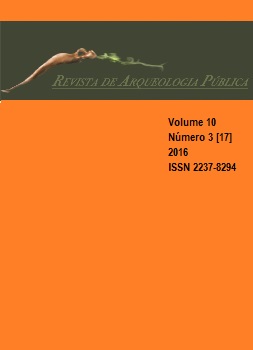Abstract
Este artigo examina a materialidade das práticas de memória no passado ao focar nos monumentos erguidos na cidade norte-americana que inspirou o feriado mais celebrado nos EUA, o Dia de Ação de Graças (Thanksgiving). Através de uma análise do contexto sócio-cultural no início do século 20, período de fabricação da maioria dos monumentos da cidade de Plymouth, evidenciam-se as circunstâncias específicas das escolhas sobre quais aspectos da história deveriam ser expostas, ou não, ao público. Ainda que no local predomine uma narrativa que sublinhe o legado dos imigrantes anglo-saxônicos, a contestação por parte de ativistas tem resultado na adição de narrativas históricas alternativas à paisagem monumental da cidade.
References
ADAMCZYK, Amy. On Thanksgiving and collective memory: constructing the American tradition. Journal of Historical Sociology, v. 15, n. 3, p. 354-365, 2002.
CALLOWAY, Colin & SALISBURY, Neal. Introduction: decolonizing New England Indian history. In Reinterpreting New England Indians and the colonial experience. Boston: The Colonial Society of Massachusetts, p. 13-23, 2003.
EICHSTEDT, J. & SMALL, S. Representations of Slavery: Race and Ideology in Southern Plantation Museums. Washington: Smithsonian, 2002.
GARCIA, Desirée. Subversive sounds: ethnic spectatorship and Boston´s Nickelodeon Theatres, 1907-1914. Film History, v. 19, n. 3, p. 213-227, 2007.
HANDLER, R. & GABLE, E. The New History in an Old Museum: Creating the Past at Colonial Williamsburg. Durham: Duke University Press, 1997.
HAYES, Katherine. Occulting the past. Conceptualizing forgetting in the history and archaeology of Sylvester Manor. Archaeological Dialogues, v. 18, n. 2, p. 197-221, 2011.
KELLY, M. Protest in Plymouth. Native Americans clash with police. The Patriot Ledger, p. 1, 28 de novembro, 1997.
KIRSHEMBLATT-GIMBLETT, Barbara. Destination Culture: Tourism, Museums, and Heritage. London: University of California Press, 1998.
LAWRENCE, D.H. Certain Americans and an Englishman. The New York Times, p. 51, 24 de dezembro, 1922.
LITTLE, Barbara. Historical archaeology: why the past matters. Walnut Creek, Left Coast Press, 2007.
MANDEL, Daniel. “We, as a tribe, will rule ourselves”:Mashpee´s struggle for autonomy, 1746-1840. In: Reinterpreting New England Indians and the colonial experience.
CALLOWAY, Colin e SALISBURY, Neal (Orgs.). Boston: The Colonial Society of Massachusetts. pp. 299-340, 2003.
MENNEL, SJ. Prohibition: a sociological view. Journal of American Studies, v. 3, n. 2, p.159-175, 1969.
MILLS, B. & WALKER, W. Introduction: Memory, Materiality, and Depositional Practice. In: Memory Work. Archaeologies of Material Practices. Santa Fé, School for Advanced Research Press, p. 3-24, 2008.
O’BRIEN, J. Firsting and Lasting. Writing Indians Out of Existence in New England. Minneapolis, The University of Minnesota Press, 2010.
OLD COLONY MEMORIAL. ‘One small candle may light a thousand’. Old Colony Memorial, p. A8, 12 de Maio, 2004.
PLYMOUTH CORDAGE HISTORICAL SOCIETY. 2012. Plymouth ropemaking led the town to prosperity. Acessado 25 de maio de 2012 em: http://www.plymouthcordagemuseum.org
REARDON, N. Indian statue was a gift from artist, but they're not sure they want it anymore. The Patriot Ledger, p. 2, 2 de dezembro, 2008.
SCHNEIDER, Mark. Ethnic regions of the United States, 1890-1970. Polity, v. 12, n. 2, p. 273-290, 1979.
SEED, Patricia. American Pentimento. Minneapolis: University of Minnesota Press, 2001.
SHACKEL, Paul. Public memory and the search for power in american historical archaeology. In: Contemporary archaeology in theory: the new pragmatism, 2ª ed. PREUCEL, R. & MROZOWSKI, S (Orgs.). Chichester: Willey-Blackwell, p. 385-403, 2010.
SILVERMAN, David. The church in New England Indian community life: a view from the islands and Cape Cod. In: Reinterpreting New England Indians and the colonial experience. CALLOWAY, Colin e SALISBURY, Neal (Orgs.). Boston: The Colonial Society of Massachusetts.pp. 264-298, 2003.
SPENCER, Martin. “Political Correctness” and the politics of identity. Sociological Forum, v. 9, n. 4, p.547-567, 1994.
THE NEW YORK TIMES ‘New Pilgrim Spirit to Lead World, Declares Harding’. The New York Times, p. 1, 2 de agosto, 1921.
THE NEW YORK TIMES. Pilgrims´ Day December 21: President Asks Nation-Wide Observance of 300th Anniversary. The New York Times, p.6, 5 de agosto, 1920 (a).
THE NEW YORK TIMES. Honor Pilgrims on Tercentenary: Lodge and Coolidge Speak at the Celebration Held at Plymouth. The New York Times, p. 13, 22 de dezembro, 1920 (b).
THE NEW YORK TIMES. Uncle Sam and the Indian: Barbaric Customs Are Vanishing, but Life and Prosperity of the Race Are Thriving. The New York Times, p. X7, 7 de dezembro, 1919.
THOMAS, David Hurst. Skull wars: Kennewick Man, archaeology, and the battle for native american identity. New York: Basic Books, 2000.
TROUILLOT, Michel-Rolph. Silencing the past: power and the production of history. Boston: Beacon Hill Press, 1995.
TYNER, J. The Geopolitics of Eugenics and the Exclusion of Philippine Immigrants from the United States. Geographical Review, v. 89, n. 1, p. 54-73, 1999.
WEEKS, Alvin. Massasoit of the Wampanoags. Fall River: Plympton Press, 1920.
WEIBLE, Robert. Visions and reality: reconsidering the creation and development of Lowell´s National Park. The Public Historian, n. 33, v. 2, p.67-93, 2011.
A Revista Arqueologia Pública utiliza a licença do Creative Commons (CC), preservando assim, a integridade dos artigos em ambiente de acesso aberto.

